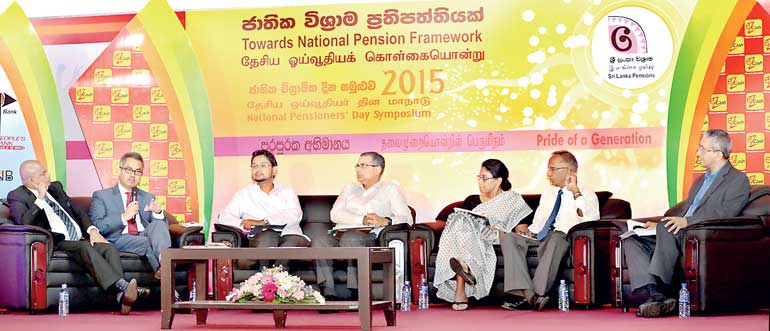Monday Jan 13, 2025
Monday Jan 13, 2025
Friday, 16 October 2015 00:00 - - {{hitsCtrl.values.hits}}
 From left: Pensions Dept DG Sunil Hettiarachchi, AIA Sri Lanka CEO Shah Rouf, Verite Research Executive Director
From left: Pensions Dept DG Sunil Hettiarachchi, AIA Sri Lanka CEO Shah Rouf, Verite Research Executive Director
Dr. Nishan De Mel, JB Securities CEO Murthaza Jafferjee, Institute of Policy Studies Research Fellow Dr. Nisha Arunatilake, University of Colombo Prof. Indralal De Silva and Moderator Nalaka Gunawardena
AIA CEO Shah Rouf was among the distinguished pensions experts who participated in the panel discussion titled ‘Towards a National Pension Framework’, moderated by Nalaka Gunawardena – science writer, journalist and development communication specialist. The National Pensioners’ Day 2015 was initiated by the Department of Pensions with background presentations and a panel discussion as part of the forum sessions.
The presentations were by University of Colombo Professor of Demography Prof. Indralal De Silva, Institute of Policy Studies Research Fellow Dr. Nisha Arunatilaka and JB Securities CEO Murthaza Jafferjee. Apart from Shah, the discussion panel included Verite Research (a think tank) Executive Director and Head of Research Dr. Nishan De Mel and Department of Pensions Director General Sunil Hettiarachchi.
Prof. Indralal De Silva spoke on demographic trends highlighting that life expectancy has risen from 32 years for males in 1920 to 68 in 2002 and 72 today. The elderly population is doubling and more females are living longer.
Dr. Nisha Arunatilaka began her presentation with the question ‘Have you thought about your retirement planning today?’ She then pointed out that there is a need to change fiscal policies because in other Asian countries the retirement age is higher while Sri Lankans are retiring prematurely and living longer, making a case for raising the retirement age. She also pointed out that not even half the female population is in employment and therefore are not entitled to get EPF. Also, 50% of senior citizens do not receive a pension and only about 20% get a government pension.
Adding to Murthaza Jafferjee’s presentation on the 4 pillar ‘ideal’ pension system – where Pillar 1 is a universal minimum state provided pension, Pillar 2, is a mandatory pension for all (similar to but not same as the EPF), Pillar 3 is a voluntary pension (such as those provided by life insurance companies) and Pillar 4 other incentivised savings that can be drawn upon – Shah commented that these systems had evolved over time in South America and Eastern Europe in the 1980s and 1990s so there were good templates for Sri Lanka to consider.
With AIA, fast becoming recognised as one of the country’s ‘pension experts’, Shah emphasised on the importance that life insurers play as Pillar 3 and 4 providers in a sustainable pension framework. “We must understand that we are personally accountable for our retirement,” said Shah.
Shah further commented: “Even the most advanced sustainable national pension systems can only provide a very basic income and in most cases even that is ‘means tested’ for the very needy. In such systems the middle classes are encouraged to accumulate funds such as EPF and other long term savings such as life insurance endowment policies to build up their pension fund. Whether within a framework that incentivises saving for a pension or not, individuals have little choice but to take ownership of their own retirement planning.”